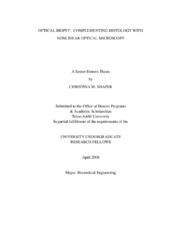| dc.description.abstract | Histology, though widely used for cellular imaging, suffers from its destructive nature; cells are not viewed in their natural living environment. Nonlinear optical microscopy (NLOM) has been widely used to view cells in situ without a need for sample processing. NLOM uses a high-powered ultrafast laser to generate nonlinear optical signals within living tissue. These signals are used to render two- and three-dimensional images. One improvement to be made on this imaging system is the capability to produce spectral images rather than merely intensity images. Spectral information provides insight to the sample’s chemical environment; this insight may lead to increased efficiency in disease diagnosis, since pathological development begins at the
iv
microscopic level. Additional detectors added to the system will allow wavelength discrimination and the creation of spectral images. To achieve this type of system, additional hardware must be built and software must be written to allow simultaneous data acquisition from 32 detectors. The initial task competed involved the scanning mechanism; a program was created to control motorized optical scanning mirrors. The next task required a circuit board to be built to interface the detectors with the computer. A sub-program was then designed to save tissue response matrices (images) as binary files. The files were able to be opened in MATLAB® and converted into scaled intensity images. The final program created used information from the circuit board (i.e. from each detector) to create the response matrix to be saved as a binary file. All hardware and software was then integrated into the current imaging system to be tested with two detectors. At this point, the new system cannot adequately render images. Future work will involve software and hardware correction until images are correctly formed. At this point, the tissue response to two different ranges of light wavelengths will able to be viewed separately, and the matrices can be added to create a grayscale image. At this point, work on this project will involve expanding the hardware and software to incorporate 30 additional detectors. The spectral detection system will allow image
v
segmentation of biological components, and chemical markers associated with cellular abnormalities as well as different genetic markers can be viewed on a microscopic level. Therefore, this system is of great value to medicine and science. | en |


